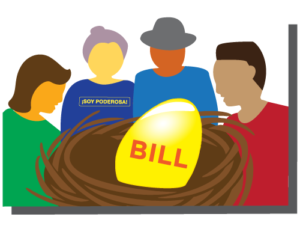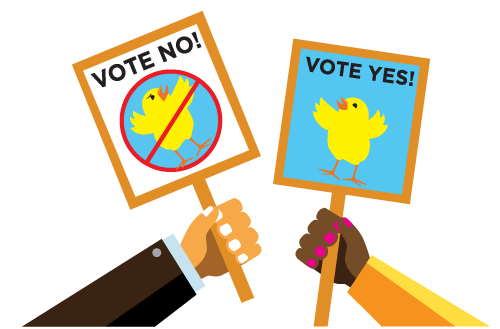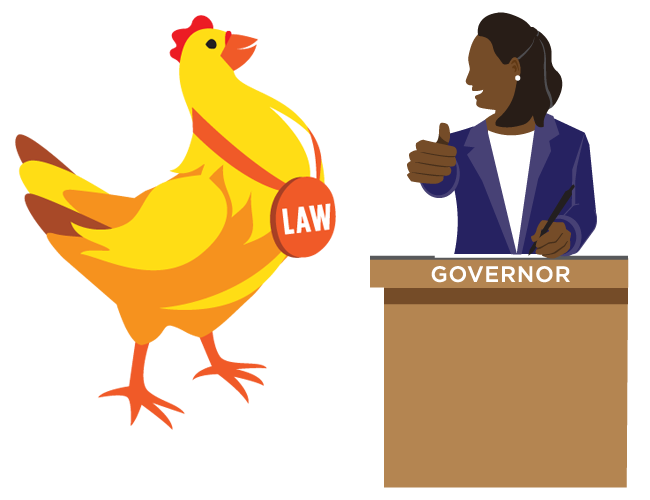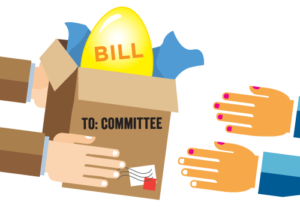Oregon – How a Bill Becomes a Law
Laws in Oregon are created by the Oregon State Legislature. The Oregon Legislature has two legislative chambers – the House of Representatives and the Senate. There are 60 members of the House of Representatives and 30 members of the Senate. The Oregon Legislature meets for 35 days in even years and 160 days in odd years.
 A bill is an idea for a new law, or an idea to change or get rid of an existing law. Ideas for bills can come from anyone – legislators, community members, organizations, even corporations.
A bill is an idea for a new law, or an idea to change or get rid of an existing law. Ideas for bills can come from anyone – legislators, community members, organizations, even corporations.
1: Introduce a Bill
2. Send to Committee
3. Committee Hears the Bill

The committee studies the bill to see if it would make a good law. Committees often hold hearings, where people testify in support of or in opposition to the bill. Members of the committee can suggest changes (called amendments) to the bill for the committee to consider.
After listening to all of the information and proposed changes, the committee will vote on the bill. If more than half of the committee members support the bill, it moves onto the next step. If the committee doesn’t vote on the bill or the bill gets defeated in committee, it cannot move on.
Forward Together leaders and supporters share their stories by testifying at committee hearings. Folks who can’t attend in person can submit written testimony into the record. Forward Together supporters can call the members of the committee to express their support or share their concern about a bill, and we often have days of action to share our experiences with legislators in person.
4. Floor Action
 A bill that is approved by committee returns to the chamber (House or Senate) where it was introduced and is read or printed in the calendar three times. To pass the first reading, the bill title is printed in the calendar (the daily printed agenda of business) or is read by the Clerk of the chamber. During the second reading, the bill may be amended and debated on the full floor. During the third reading, members vote to pass or not pass the bill. Bills that don’t pass on the third reading do not move on in the process.
A bill that is approved by committee returns to the chamber (House or Senate) where it was introduced and is read or printed in the calendar three times. To pass the first reading, the bill title is printed in the calendar (the daily printed agenda of business) or is read by the Clerk of the chamber. During the second reading, the bill may be amended and debated on the full floor. During the third reading, members vote to pass or not pass the bill. Bills that don’t pass on the third reading do not move on in the process.
 If a bill passes in the House of Representatives, it goes through a similar process in the Senate. Before a bill becomes law, it must be approved by both chambers of the legislature. The bill must pass with the same wording in the House of Representatives and the Senate before it can go to the Governor. If the Senate amends a House bill, or vice versa, the bill must go back to the original chamber and be approved with the amendments before proceeding.
If a bill passes in the House of Representatives, it goes through a similar process in the Senate. Before a bill becomes law, it must be approved by both chambers of the legislature. The bill must pass with the same wording in the House of Representatives and the Senate before it can go to the Governor. If the Senate amends a House bill, or vice versa, the bill must go back to the original chamber and be approved with the amendments before proceeding.
When a bill is being considered on the chamber floor, Forward Together leaders participate in days of action, calling or visiting legislators to express their support or opposition to a bill. We may also show up at the Capitol building on the day of a floor vote to rally, speak to the media, and do in-person storytelling with legislators.
5. Governor's Desk

If the bill passes both chambers, it goes to the Governor for approval. The Governor has three choices:
- Governor signs the bill.
- Governor vetoes (or rejects) the bill. The House of Representatives and Senate may override the veto by a two-thirds vote of each chamber.
- Governor takes no action. If the Governor doesn’t sign the bill, but doesn’t veto it, it automatically becomes the law.
While a bill is waiting for the Governor to make a decision, Forward Together leaders and supporters call the Governor’s office, send emails, and participate in social media campaigns to urge the Governor to sign or veto the bill.
About This Tool
Forward Together works to ensure all Oregon families have the rights, recognition and resources they need to thrive. We work with women of color and trans/nonbinary individuals and their families on healthcare access, rights for all families, and building safe communities. One way we build power is by working to change laws and policies in Oregon.
Interested in Building Power for Our Families?
Contact Michele Ruffin at michele@forwardtogether.org.
 A member of the House of Representatives or the Senate can introduce a bill. The member who introduces the bill is called the chief sponsor.
A member of the House of Representatives or the Senate can introduce a bill. The member who introduces the bill is called the chief sponsor. Once introduced, a bill gets assigned a number, and then the bill is sent to a committee. The House of Representatives has 13 committees and the Senate has 13 committees.
Once introduced, a bill gets assigned a number, and then the bill is sent to a committee. The House of Representatives has 13 committees and the Senate has 13 committees.